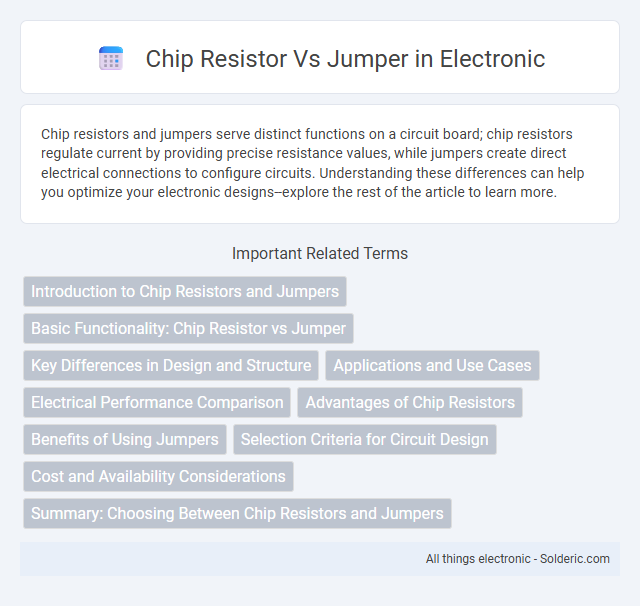Chip resistors and jumpers serve distinct functions on a circuit board; chip resistors regulate current by providing precise resistance values, while jumpers create direct electrical connections to configure circuits. Understanding these differences can help you optimize your electronic designs--explore the rest of the article to learn more.
Comparison Table
| Feature | Chip Resistor | Jumper |
|---|---|---|
| Function | Limits current, divides voltage | Connects two points electrically |
| Component Type | Passive electronic component | Connector or wire bridge |
| Typical Usage | Current control, signal conditioning | Signal routing, circuit customization |
| Size | Small, surface-mount (e.g., 0603, 0805) | Small wire or PCB trace jumper |
| Resistance | Fixed, specified values (ohms) | Near zero, minimal resistance |
| Installation | Soldered on PCB pads | Soldered or removable clip |
| Application Example | Voltage divider, current limiter circuits | Enable or disable circuit paths |
Introduction to Chip Resistors and Jumpers
Chip resistors are small, surface-mount electronic components designed to provide precise resistance in circuit boards, offering high reliability and stability in various applications. Jumpers serve as short conductive links used to configure or bypass circuits by connecting specific points on a PCB, enabling easy modifications without altering the main design. Both chip resistors and jumpers play crucial roles in electronic assembly, ensuring proper circuit functionality and customization.
Basic Functionality: Chip Resistor vs Jumper
A chip resistor limits electrical current and controls voltage within circuits by providing precise resistance values, essential for accurate signal management. A jumper, however, acts as a simple conductive bridge, establishing or breaking connections without adding resistance, often used for circuit configuration or bypassing components. Understanding the basic functionality differences between your chip resistor and jumper helps optimize circuit design and troubleshooting.
Key Differences in Design and Structure
Chip resistors feature a compact, rectangular ceramic body with resistive material printed on the surface for precise resistance control, while jumpers are simple conductive bridge components designed to establish or bypass electrical connections on a circuit board. The chip resistor's layered construction includes metal terminals for soldering, providing stable resistance values, whereas jumpers consist of a short wire or metal strip encased in plastic or bare metal for direct conductivity. Understanding these structural differences helps you select the appropriate component for controlling current versus creating circuit pathways.
Applications and Use Cases
Chip resistors are essential in precise electronic circuits, providing controlled resistance in devices like smartphones, computers, and automotive electronics. Jumpers serve as simple connectors or short circuits in printed circuit boards (PCBs), enabling configuration changes or bridging tracks during prototyping and troubleshooting. Your choice depends on whether you need resistance for current control or a conductive path for signal routing.
Electrical Performance Comparison
Chip resistors provide precise resistance values with minimal noise and superior stability, making them ideal for controlling current and voltage in electronic circuits. Jumpers, designed primarily for creating straightforward electrical connections with negligible resistance, serve mainly as conductors rather than components influencing circuit resistance or signal integrity. The choice between a chip resistor and a jumper in electrical design hinges on the need for controlled resistance versus simple connectivity without impacting the circuit's electrical characteristics.
Advantages of Chip Resistors
Chip resistors offer precise resistance values, stable performance, and excellent reliability in electronic circuits, making them ideal for modern compact designs. Their small size allows for efficient use of PCB space and improved automated assembly, enhancing production speed and consistency. You benefit from their durability and minimal signal interference, which contribute to overall circuit efficiency and longevity.
Benefits of Using Jumpers
Jumpers provide flexible circuit customization and easy modification during prototyping by allowing quick connections or disconnections without desoldering. Unlike chip resistors, jumpers enable simpler fault isolation and troubleshooting since they create clear, short-circuit paths or open circuits. Their use reduces assembly time and enhances adaptability in dynamic electronic designs, making them ideal for testing and reconfiguration.
Selection Criteria for Circuit Design
Chip resistors are preferred in circuit designs requiring precise resistance values, high reliability, and minimal size, making them suitable for fixed resistor roles in compact electronic devices. Jumpers serve as configurable connections allowing designers to easily open or close circuits for testing, customization, or debugging, typically selected for flexibility rather than precision resistance. Selection criteria hinge on the need for fixed resistance accuracy versus adjustable circuit routing, with chip resistors favored for stable, long-term applications and jumpers for temporary or reconfigurable circuit paths.
Cost and Availability Considerations
Chip resistors offer a cost-effective solution with widespread availability due to mass production and standardized sizes, making them affordable for high-volume manufacturing. Jumper components tend to be slightly more expensive and are less commonly stocked, often requiring custom or low-volume orders that increase procurement time. The choice between a chip resistor and a jumper depends heavily on budget constraints and the ease of sourcing components for a given project.
Summary: Choosing Between Chip Resistors and Jumpers
Chip resistors provide precise resistance values crucial for controlling current flow and voltage in electronic circuits, making them ideal for fine-tuned circuit design and signal conditioning. Jumpers serve as simple, low-resistance connectors that create or break circuit connections without affecting electrical characteristics, commonly used for configuration settings or circuit bridging. Selecting between chip resistors and jumpers depends on whether precise resistance control or straightforward connectivity is required for the specific application.
Chip Resistor vs Jumper Infographic

 solderic.com
solderic.com